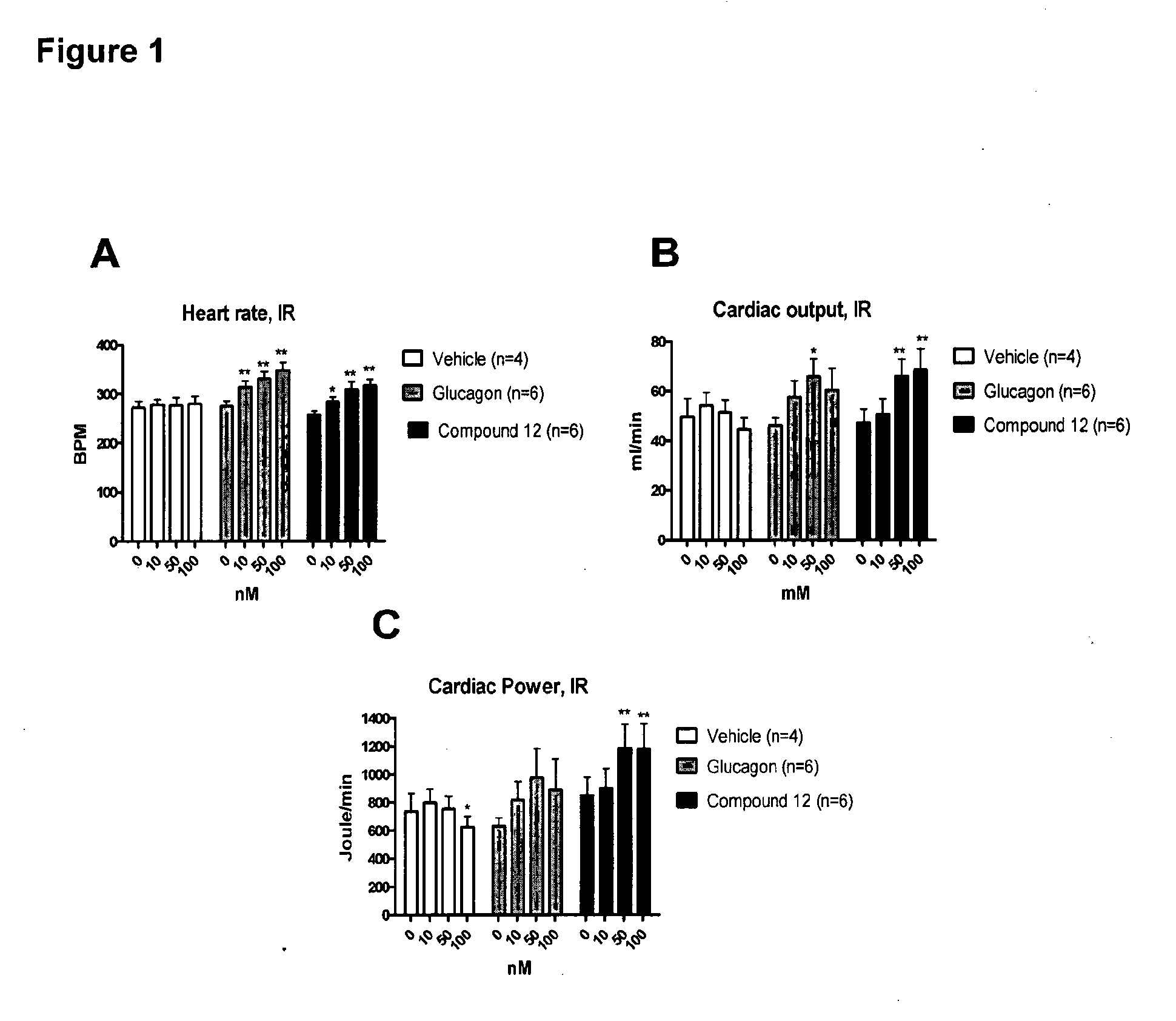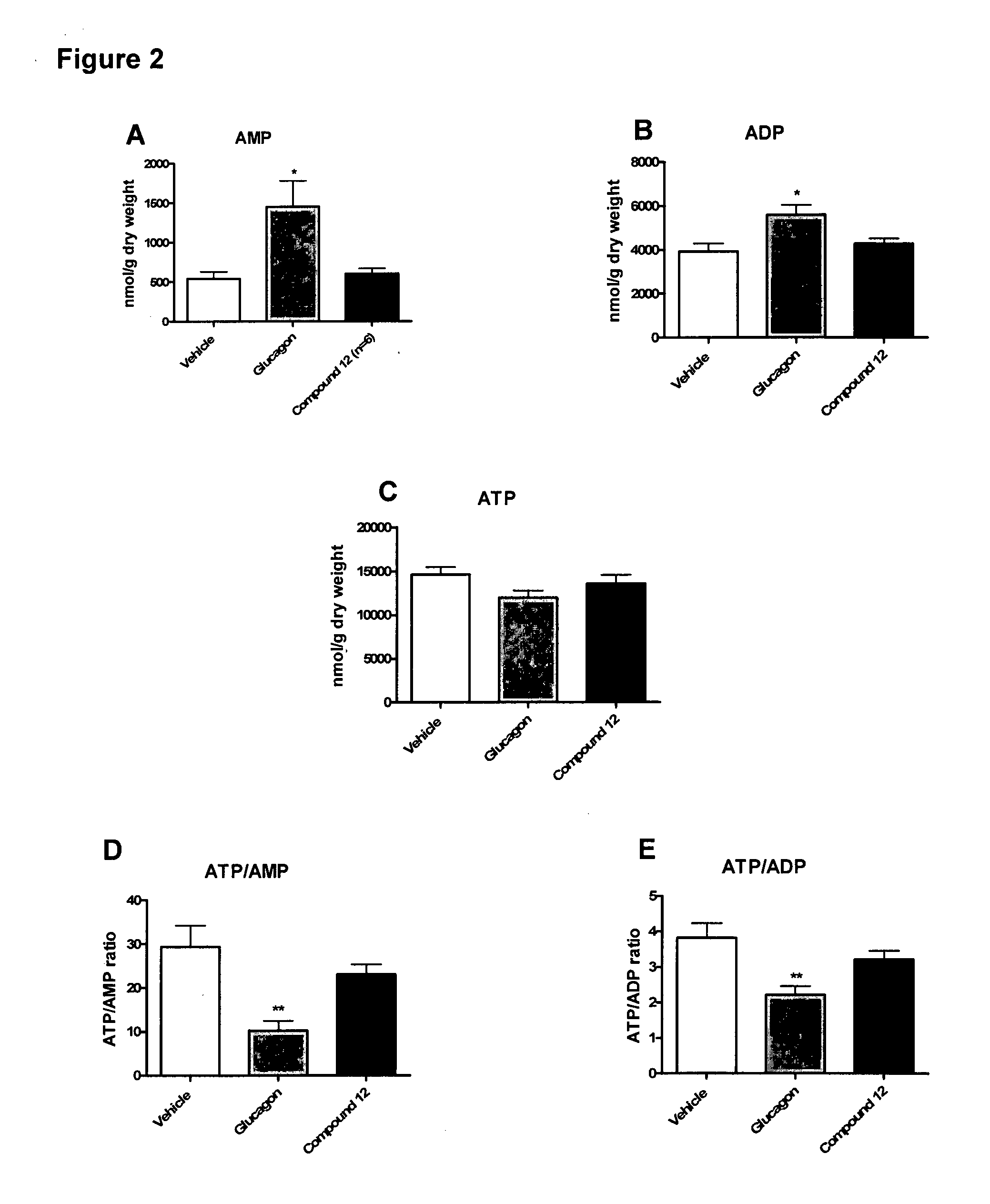Treatment of cardiac conditions
a technology of glucagonglp1 and agonist, applied in the field of treatment of cardiac conditions, can solve the problems of increasing mortality, energy depletion, and energy starvation of failing or diseased hearts, and achieve the effect of less effect on heart energy status
- Summary
- Abstract
- Description
- Claims
- Application Information
AI Technical Summary
Benefits of technology
Problems solved by technology
Method used
Image
Examples
example 1
Assessment of Inotropic Effect in Working Heart Model
[0300]The effect of the inotropic compound glucagon and a glucagon-GLP-1 dual-agonist (Compound 12 having the sequence HSQGTFTSDYSKYLDRARADDFVAWLKST (SEQ ID NO: 12)) on cardiac function, metabolism, and energy state was evaluated in isolated working hearts (Lopaschuk, G D and Barr, R L. Measurements of fatty acid and carbohydrate metabolism in the isolated working rat heart. Molecular and Cellular Biochemistry. 1997; 172: 137-147) from control and insulin-resistant JCR:LA-cp rats. Isolated working hearts were subjected to aerobic perfusion with Krebs-Henseleit solution (11 mM glucose, 2000 μU / ml insulin, 1.25 mM free Ca2+, 0.8 mM palmitate, and 3% BSA) and during perfusion increasing concentrations (10, 50, and 100 mM) of glucagon or Compound 12 was added to the perfusion buffer. Following perfusions, high energy phosphate nucleotide concentrations were measured by high performance liquid chromatography (HPLC) (Ally, A and Park, G...
example 2
Determination of Efficacy at GLP-1 and Glucagon Receptors
[0302]HEK293 cells expressing the human glucagon receptor or human GLP-1R (see above for details) were seeded at 40,000 cells per well in 96-well microtiter plates coated with 0.01% poly-L-lysine and grown for 1 day in culture in 100 μl growth medium. On the day of analysis, growth medium was removed and the cells washed once with 200 μl Tyrode buffer. Cells were incubated in 100 Tyrode buffer containing increasing concentrations of test peptides, 100 μM IBMX, and 6 mM glucose for 15 min at 37° C. The reaction was stopped by addition of 25 μl 0.5 M HCl and incubated on ice for 60 min. The cAMP content was estimated using the FlashPlate® cAMP kit from Perkin-Elmer. EC50 values were estimated by computer aided curve fitting.
[0303]Table 1 shows results for sample compounds as EC50 values.
CompoundEC50EC50No. / SEQ(nM)(nM)ID NO:Test compoundGLP-1RGuR1H-HSQGTFTSDYSKYLDSRRAQDFVWLMNT-OH2.00.1(Human glucagon)12H-HSQGTFTSDYSKYLDRARADDFVAW...
example 3
Assessment of Inotropic Effect In Vivo in Aneasthetized Rats
[0304]The effect of the inotropic compound 1 and a glucagon-GLP-1 dual-agonist (Compound 12 on cardiac function, and heart rate was examined in anesthetized male Sprague-Dawley rats weighing approximately 300-400 g (Taconic).
[0305]The rats were exposed to 5% isoflurane in 1:2 N2O:O2 until anesthesia were established. Body temperature was kept constant (37.5±0.5° C.) and the animals were artificially ventilated through an endotracheal cannula and anesthesia was maintained.
[0306]A catheter was inserted into the left femoral vein for drug administration and a pressure-volume catheter was inserted into the left ventricle via the right carotid artery. After instrumentation, isoflurane was delivered in pure O2 during the experiment. After 20 min of stabilization, baseline data was recorded for 15 min while infusing vehicle (at 7 μL / min). Subsequently, compounds were infused After the infusion of the 2.5 nmol / kg / min dose (or a low...
PUM
| Property | Measurement | Unit |
|---|---|---|
| Fraction | aaaaa | aaaaa |
| Fraction | aaaaa | aaaaa |
| Lipophilicity | aaaaa | aaaaa |
Abstract
Description
Claims
Application Information
 Login to View More
Login to View More - R&D
- Intellectual Property
- Life Sciences
- Materials
- Tech Scout
- Unparalleled Data Quality
- Higher Quality Content
- 60% Fewer Hallucinations
Browse by: Latest US Patents, China's latest patents, Technical Efficacy Thesaurus, Application Domain, Technology Topic, Popular Technical Reports.
© 2025 PatSnap. All rights reserved.Legal|Privacy policy|Modern Slavery Act Transparency Statement|Sitemap|About US| Contact US: help@patsnap.com



